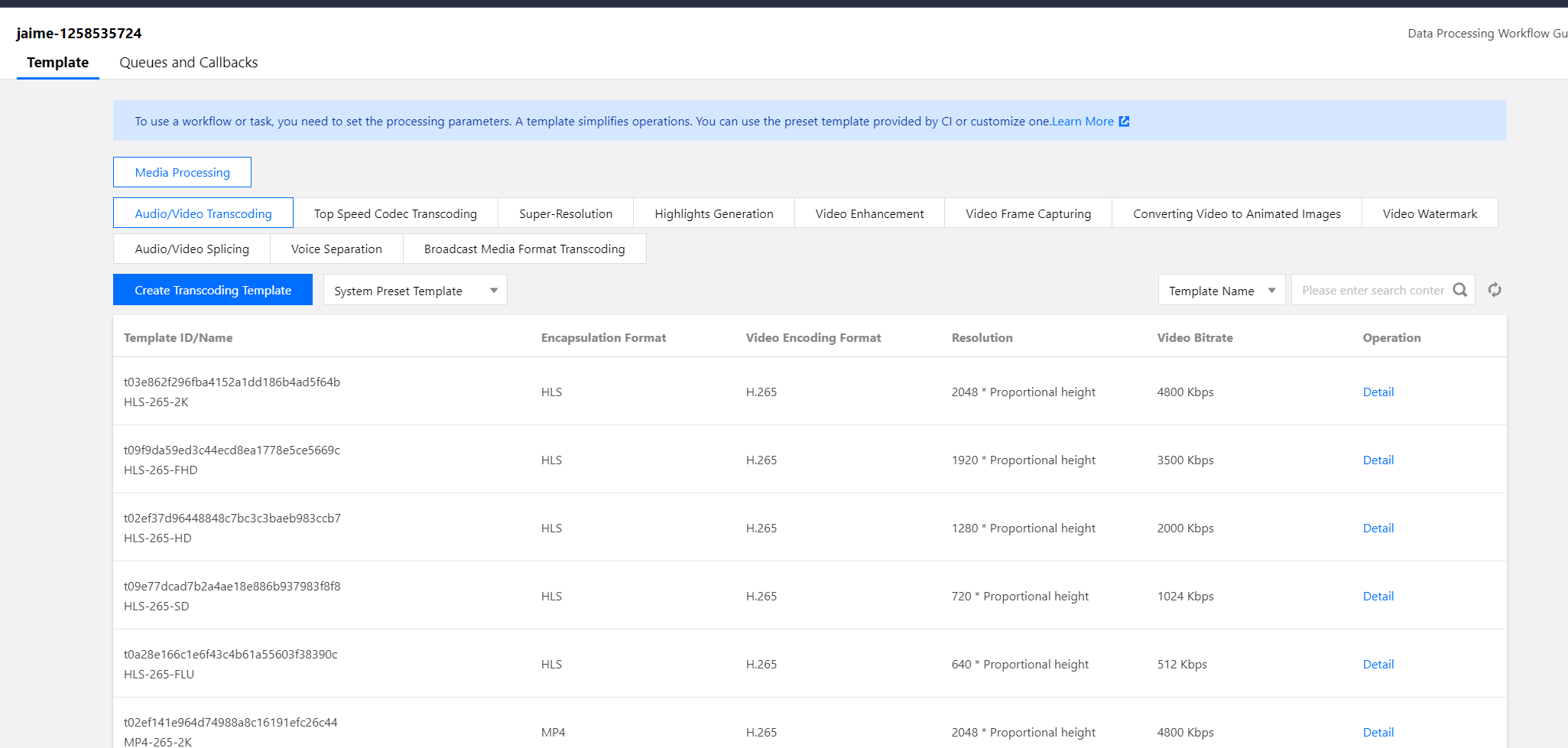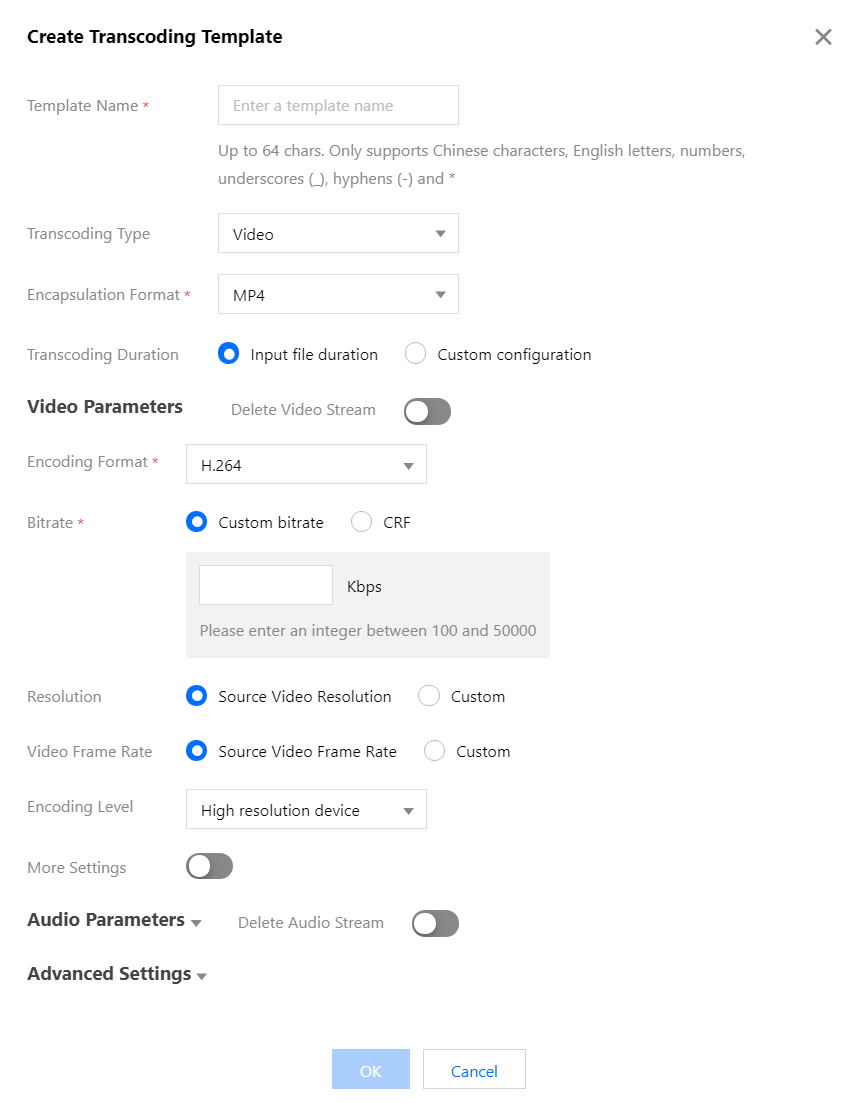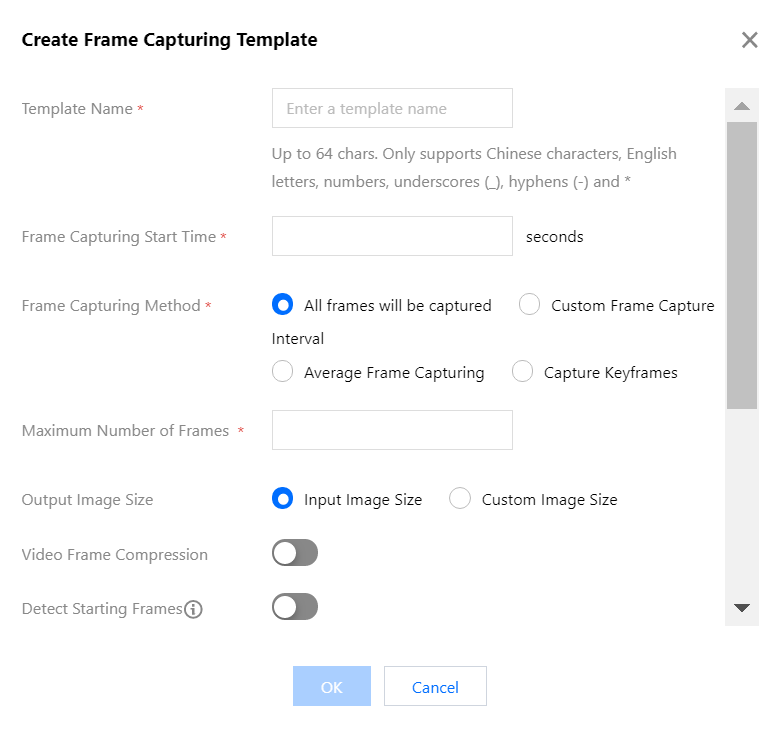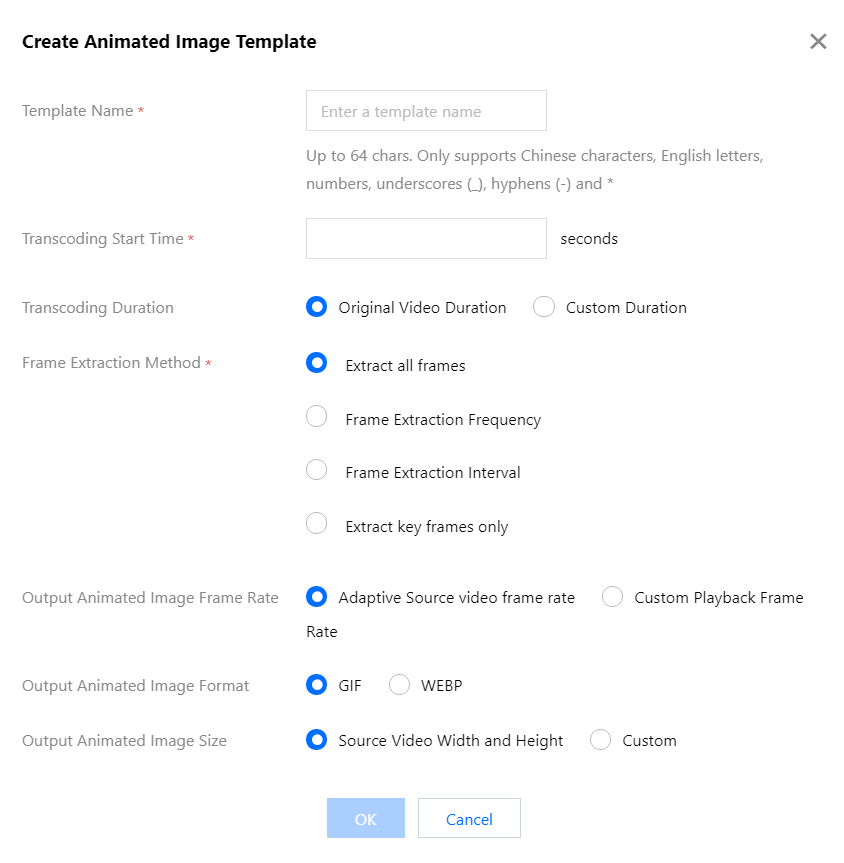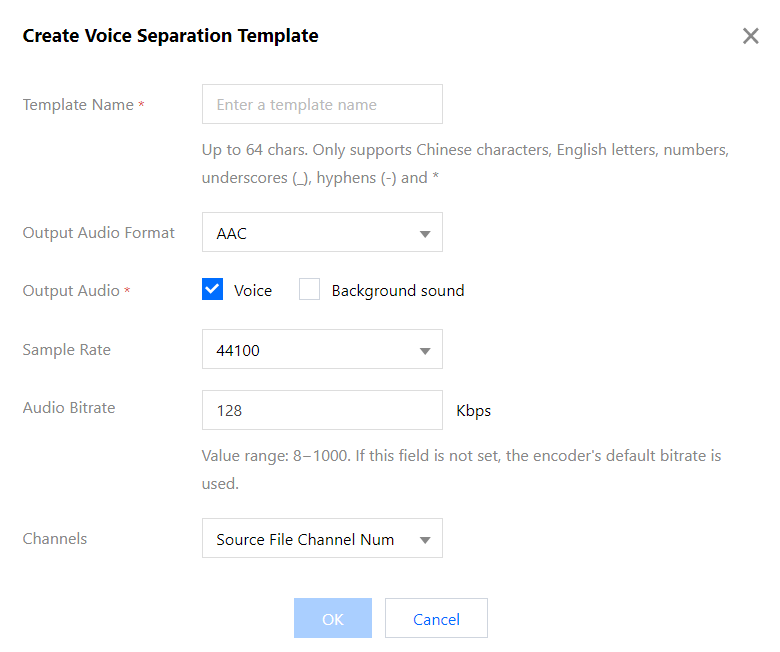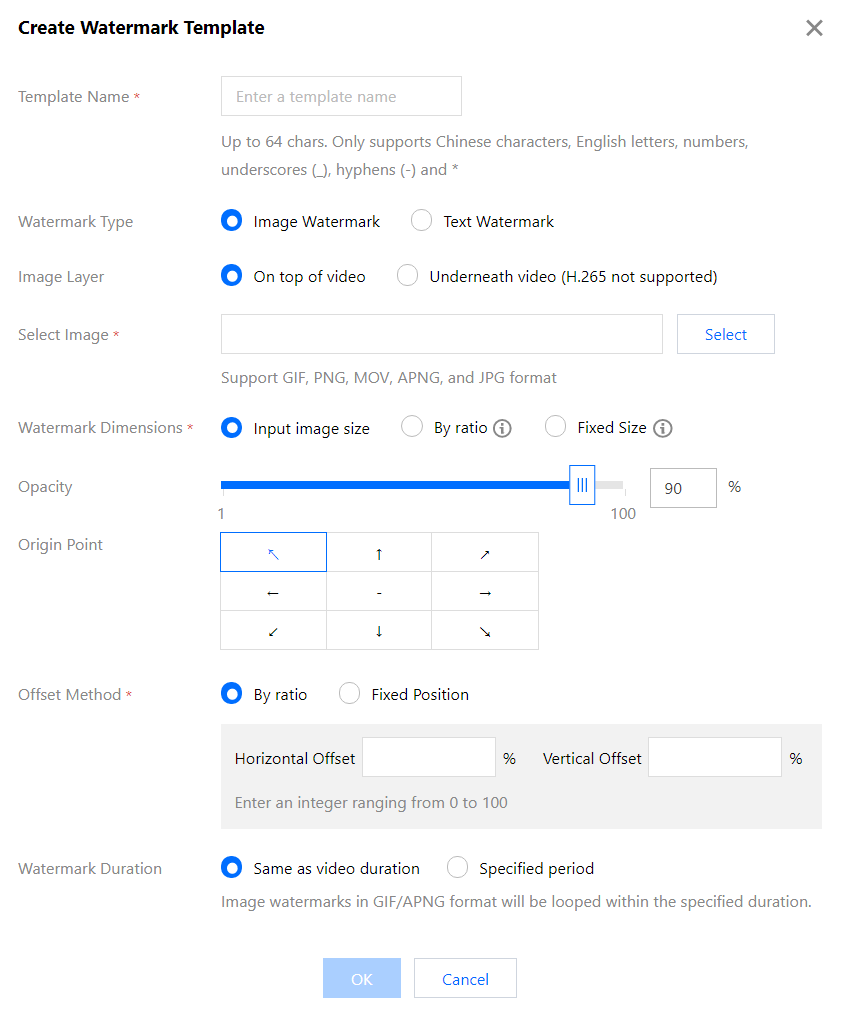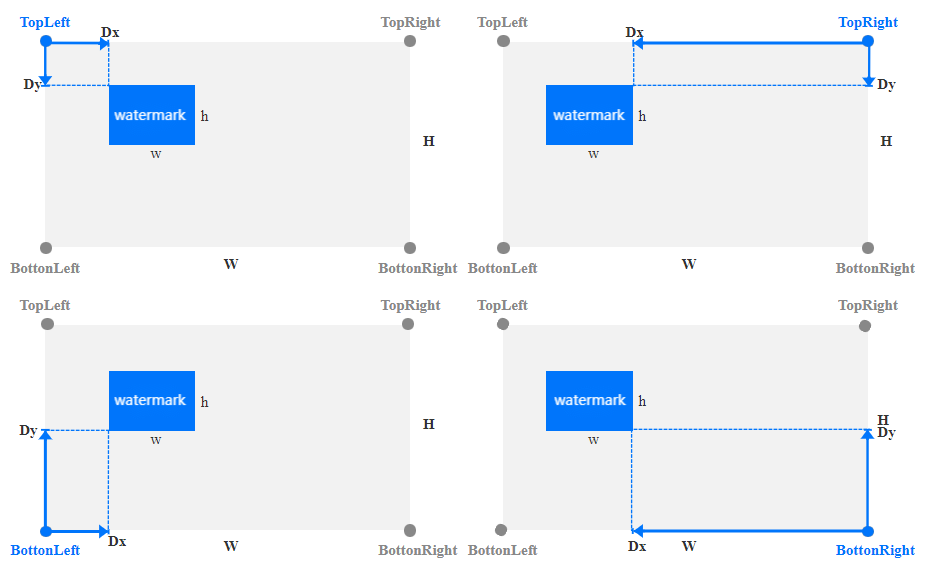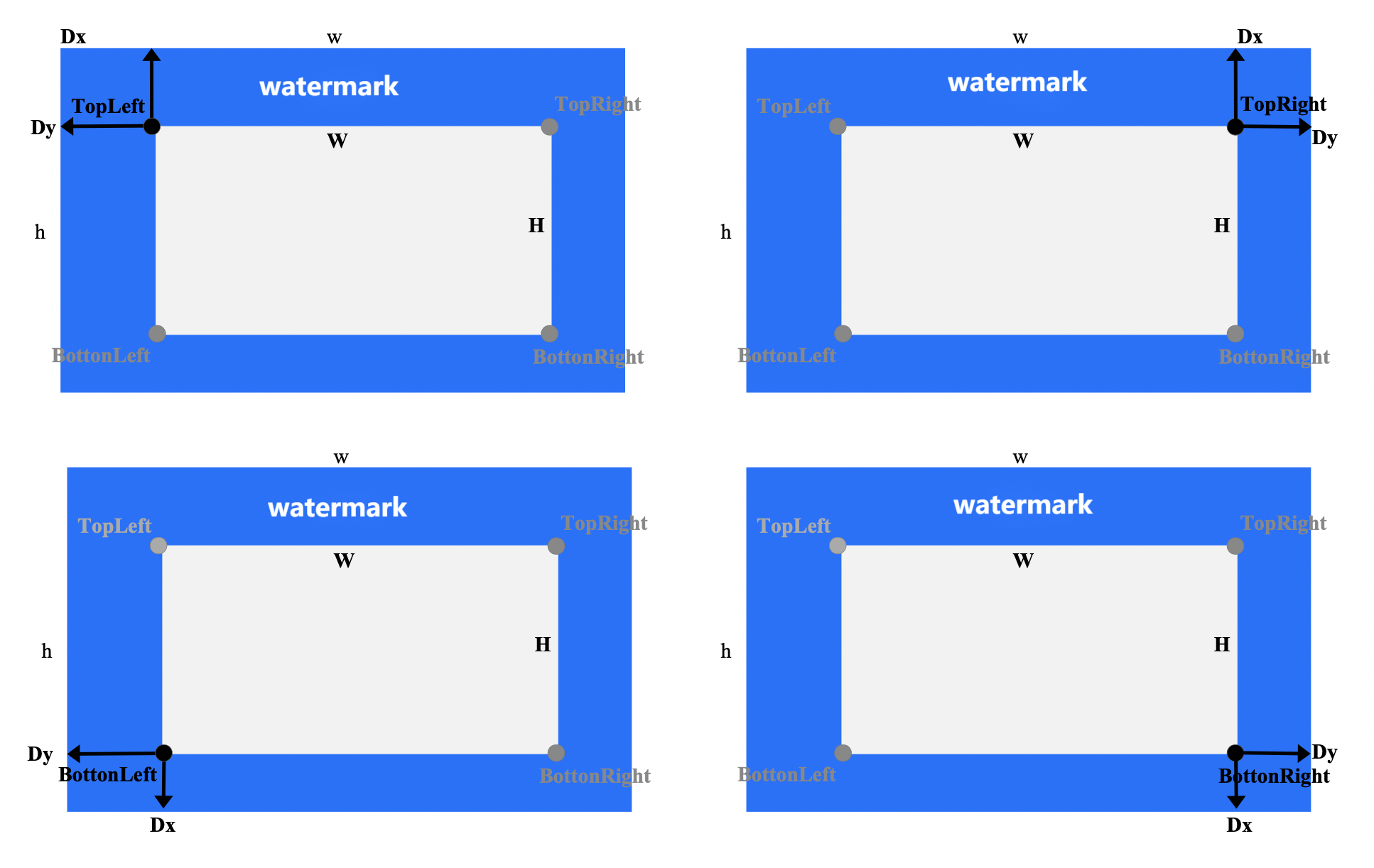Overview
When using the media processing feature, you usually need to set a series of parameters, which can be combined through a template. This simplifies your operations and allows you to reuse the configured parameters with no need to enter them repeatedly.
For media processing features such as audio/video transcoding, audio/video splicing, video frame capturing, and video-to-animated image conversion, you need to specify a template when creating a job or workflow in CI. The template page provides preset templates, and you can also customize templates based on your business needs. Preset Templates
The CI system combines common parameters in advance into preset templates, so that you can use them directly. When creating a job or workflow, you can select such a template by the template name.
On the bucket management page, click Job and Workflow > Template Configuration to view templates of different processing types. Click View on the right of a template to view its detailed information.
Note:
Currently, the system provides 15 audio/video transcoding, three video frame capturing, and 18 video-to-animated image conversion preset templates.
You can only view the information of preset templates but cannot edit or delete them.
Preset templates for audio/video transcoding
|
t0e2b9f4cd25184c6ab73d0c85a6ee9cb5 | | | | 640 * proportionally scaled | | | |
t0876739cd865042d1957d73c78f0484fb | | | | 720 * proportionally scaled | | | |
t0852e7ff4acd4484e99ba104f3840d3cb | | | | 1280 * proportionally scaled | | | |
t04df9eb0c373c4a8780ec894ce05469a7 | | | | 1920 * proportionally scaled | | | |
t09d027135634d47048e5a30dc1e19ee90 | | | | 2048 * proportionally scaled | | | |
t0e634622e8dfb49339ba478d60ddc7188 | | | | 640 * proportionally scaled | | | |
t0fa5bdbf58bb348e88bf73fae5d674fdf | | | | 720 * proportionally scaled | | | |
t09d0f419921e44ed98190f355ec9fd629 | | | | 1280 * proportionally scaled | | | |
t080ae8a06f9074f3daa46201078f8d4b1 | | | | 1920 * proportionally scaled | | | |
t0ab68939cef0f40d19c4a135df540239f | | | | 2048 * proportionally scaled | | | |
t0e165bef65ed24d568eeecc8661248af6 | | | | 640 * proportionally scaled | | | |
t057d0410c32444e48b9220f9571e6097a | | | | 720 * proportionally scaled | | | |
t00daf332ba39049f8bfb899c1ed0134b0 | | | | 1280 * proportionally scaled | | | |
t0d41905a814434c8a81897ecb54d53a32 | | | | 1920 * proportionally scaled | | | |
t0e287e59454b94a8983ba78a6a30ee864 | | | | 2048 * proportionally scaled | | | |
Preset templates for video frame capturing
|
t01d40e440761448fc8c538fb8d5a5b81e | | | | | | |
t0a60a2bc71a4b40c7b3d7f7e8a2779a81 | | | | | | |
t07740e32081b44ad7a0aea03adcffd54a | | | | | | |
Preset templates for video-to-animated image conversion
|
t04373959a69c04d47b62fd214dd13d8e9 | | | | Only keyframes are extracted | | | | |
t0341b0ab2b8a340ff826e9cb4f3a7baea | | | | One frame is extracted every 10s | | | | |
t046b1d8e5bdf842c6a58d8028b48eafee | | | | Ten frames are extracted per second | | | | |
t0ef2077f215864c018a2fca73614ceca6 | | | | Only keyframes are extracted | | | | |
t0d21406ca737a40869973a37a5daa349a | | | | One frame is extracted every 10s | | | | |
t0878a9c9c1f054cb5bca68b8b06e556c2 | | | | Ten frames are extracted per second | | | | |
t0dae821708cea4ba5b3e271810ac80a21 | | | | Only keyframes are extracted | | | | |
t03fef67ad94d2466b9c0c89252ed72e87 | | | | One frame is extracted every 10s | | | | |
t030a64e9f9f5a4f53a9ef64bb7ce490b5 | | | | Ten frames are extracted per second | | | | |
t03b0e9eca4fc34e2cba9da89d9c7c13a2 | | | | Only keyframes are extracted | | | | |
t016fcddf6bc3c44b793e9b7b07119b4ee | | | | One frame is extracted every 10s | | | | |
t0bf1f1ce6d2404b258c0f81fbb9aaece1 | | | | One frame is extracted every 10s | | | | |
t098d6d3fcfd2c45309a408594a42559f6 | | | | Only keyframes are extracted | | | | |
t0169a6a9c2eec4b51972eb63bafcbf08d | | | | One frame is extracted every 10s | | | | |
t0ef9ba537011e4876b8777aebc19d10a5 | | | | One frame is extracted every 10s | | | | |
t02743d344b5e74c579e50e9e135b432b8 | | | | Only keyframes are extracted | | | | |
t0dd27c136ff2741538bec96981e058868 | | | | One frame is extracted every 10s | | | | |
t00ad05235d67a45a9a697b553052b7346 | | | | One frame is extracted every 10s | | | | |
Custom Template
If preset templates cannot meet your needs, use custom templates. Currently, you can create custom templates for audio/video transcoding, top speed codec transcoding, broadcast media format transcoding, image processing, highlights generation (also known as video montage), voice separation (also known as voice/sound separation), video enhancement, super resolution, video frame capturing, video-to-animated image conversion, video watermark, and audio/video splicing.
Audio/Video transcoding
The audio/video transcoding feature converts an audio/video file bitstream. It changes parameters of the source bitstream, such as codec, resolution, and bitrate, to adapt to different devices and network conditions. You can customize the template parameters in a custom audio/video transcoding template.
Directions
2. Click Bucket Management on the left sidebar to enter the bucket list.
3. Click Manage in the Operation column on the right of the target bucket to enter the bucket management page.
4. On the left sidebar, click Data Processing Workflow > Common Configuration and select the Template tab at the top to enter the template configuration page.
5. Select Audio/Video Transcoding and click Create Transcoding Template.
6. In the Create Transcoding Template pop-up window, configure the following items:
</br>
The configuration information of the audio/video transcoding template is as follows: Template Name: It can contain up to 64 letters, digits, underscores (_), hyphens (-), and asterisks (*).
Container Format: Supported formats include MP4, FLV, HLS, TS, and MKV.
Transcoding Duration: You can select the input video duration or customize the duration.
Video Parameters
Encoding Format: Convert the input video to the selected encoding format.
Bitrate: Customize the bitrate or adjust the bitrate through CRF.
Resolution: Control the frame size of the output video.
Video Frame Rate: Set the frequency in frames at which a bitmap image appears continuously on the display.
Encoding Level: Control the compression ratio of the video.
Audio Parameters: Customize audio parameters as needed.
7. Click OK.
After successfully creating the template, you can view, edit, or delete it in the custom template list.
Note:
You can apply the audio/video transcoding template when creating a job or workflow in CI. Video frame capturing
CI's video frame capturing feature captures the frames of a video at specified time points. The output screenshots are in JPG format. You can customize the template name, frame capturing start time, frame capturing interval, captured frames, and output image size and format in a custom video frame capturing template.
Directions
2. Click Bucket Management on the left sidebar to enter the bucket list.
3. Click Manage in the Operation column on the right of the target bucket to enter the bucket management page.
4. On the left sidebar, click Job and Workflow > Template Configuration to enter the template configuration page.
5. Select Video Frame Capturing and click Create Video Frame Capturing Template.
6. In the Create Video Frame Capturing Template pop-up window, configure the following items:
The configuration information of the video frame capturing template is as follows: Template Name: It can contain up to 64 letters, digits, underscores (_), hyphens (-), and asterisks (*).
Frame Capturing Start Time: You can select any time point within the full video length.
Frame Capturing Method
All frames will be captured by default: Every video frame will be captured.
Custom Frame Capturing Interval: Frames will be captured at specified time intervals from the frame capturing start time to the end of the video.
Even Frame Capturing: Frames will be captured at even intervals calculated based on the specified number of captured frames from the frame capturing start time to the end of the video.
Capture Keyframes: Keyframes will be captured based on the specified number of captured frames from the frame capturing start time to the end of the video.
Max Frame Count Per Video: This parameter is required if you select All frames will be captured by default, Custom Frame Capturing Interval, or Capture Keyframes as the frame capturing method.
Captured Frames: This parameter is required if you select Even Frame Capturing as the frame capturing method. Frames will be captured at even intervals calculated based on the specified number of frames captured from the frame capturing start time to the end of the video.
Output Image Size: The default output screenshot size is the same as that of the input video image. If you select custom image size, you must enter an integer between 128 and 4096 for the width and height respectively.
7. Click OK.
After successfully creating the template, you can view, edit, or delete it in the custom template list. You can click Preview to view the position and dimensions of the watermark in videos of three common resolutions and quickly adjust the template.
Note:
You can apply the video frame capturing template when creating a job or workflow in CI. Video-to-animated image conversion
The video-to-animated image conversion feature converts a video to animated images. You can customize the template name, transcoding start time, transcoding duration, frame extraction method, output animated image frame rate, and output animated image size in a custom video-to-animated image conversion template.
Directions
2. Click Bucket Management on the left sidebar to enter the bucket list.
3. Click Manage in the Operation column on the right of the target bucket to enter the bucket management page.
4. On the left sidebar, click Job and Workflow > Template Configuration to enter the template configuration page.
5. Select Video-to-Animated Image Conversion and click Create Video-to-Animated Image Conversion Template.
6. In the Create Video-to-Animated Image Conversion Template pop-up window, configure the following items:
The configuration information of the video-to-animated image conversion template is as follows: Template Name: It can contain up to 64 letters, digits, underscores (_), hyphens (-), and asterisks (*).
Transcoding Start Time: You can select any time point within the full video length.
Transcoding Duration: It specifies the duration of video transcoding after the transcoding start time. You can select Original Video Duration or Custom.
Frame Extraction Method
Extract all frames: Every video frame will be extracted.
Frame Extraction Frequency: You can set the number of frames to be extracted per second (an integer between 1 and 50).
Frame Extraction Interval: Frame will be extracted at the specified intervals in seconds.
Extract key frames only: The system will intelligently identify and extract the optimal set of frames based on AI understanding of the video content and output them as an animated image.
Output Animated Image Frame Rate: If Adaptive is selected, the system will automatically select an appropriate frame rate based on the settings of the above parameters. You can also select Custom Playback Frame Rate to restrict the frame rate to 1–60 FPS.
Output Animated Image Format: The output animated image is in GIF format by default. If you select the WEBP format, you need to select the animated image quality, which ranges from 1 to 99 and is 75 by default.
Output Animated Image Size: The default output animated image size is the same as that of the input video. If you select custom width and height, you must enter an integer between 128 and 4096 for the width and height respectively.
7. Click OK.
After successfully creating the template, you can view, edit, or delete it in the custom template list.
Note:
You can apply the video-to-animated image conversion template when creating a job or workflow in CI. Highlights generation
The highlights generation feature automatically extracts highlights from a video. You can use a custom template to set the highlights generation template name and specify the maximum duration, resolution, and format of the output highlight video.
Directions
2. Click Bucket Management on the left sidebar to enter the bucket list.
3. Click Manage in the Operation column on the right of the target bucket to enter the bucket management page.
4. On the left sidebar, click Job and Workflow > Template Configuration to enter the template configuration page.
5. Select Highlights Generation and click Create Highlights Generation Template.
6. In the Create Highlights Generation Template pop-up window, configure the following items:
Note:
Currently, highlights generation can be used only for landscape, food, street, and vlog scenarios and will support more scenarios in the future. If you want to customize this feature, contact us for assistance. The configuration information of the highlights generation template is as follows:
Template Name: It can contain up to 64 letters, digits, underscores (_), hyphens (-), and asterisks (*).
Container Format: Supported formats include MP4, FLV, HLS, TS, and MKV.
Highlight Video Duration: You can select the duration of the complete output highlight video after automatic analysis or customize the duration.
Video Parameters
Encoding Format: Convert the input video to the selected encoding format.
Bitrate: Customize the bitrate or adjust the bitrate through CRF.
Resolution: Control the frame size of the output video.
Video Frame Rate: Set the frequency in frames at which a bitmap image appears continuously on the display.
Audio Parameters: Customize audio parameters as needed.
7. Click OK.
After successfully creating the template, you can view, edit, or delete it in the custom template list.
Note:
You can apply the highlights generation template when creating a job or workflow in CI. Video enhancement
The video enhancement feature uses AI to improve the video quality and enhance the video colors and details visually.
Directions
1. Log in to the CI console and click Bucket Management on the left sidebar to enter the bucket list. 2. Click Manage in the Operation column on the right of the target bucket to enter the bucket management page.
3. Click Job and Workflow > Template Configuration on the left to enter the template configuration page.
4. Select Video Enhancement and click Create Video Enhancement Template.
5. In the Create Video Enhancement Template window, configure the following items:
Note:
Currently, video enhancement supports color and detail enhancement. Other features will be provided in the future.
The input video for enhancement must be shorter than 30 minutes.
Template Name: It can contain up to 64 letters, digits, underscores (_), hyphens (-), and asterisks (*).
Color Enhancement: Customize the color enhancement parameters or select automatic system analysis for color enhancement.
Detail Enhancement: Customize the detail enhancement parameters or select automatic system analysis for detail enhancement.
6. Click OK.
After successfully creating the template, you can view, edit, or delete it in the custom template list.
Super resolution
The super resolution feature reconstructs a series of low-resolution images through AI technologies to generate a high-resolution image.
Directions
1. Log in to the CI console and click Bucket Management on the left sidebar to enter the bucket list. 2. Click Manage in the Operation column on the right of the target bucket to enter the bucket management page.
3. Select the Data Processing Workflow > Common Configuration tab on the left and click Template at the top to enter the template configuration page.
4. Select Super Resolution and click Create Super Resolution Template.
5. In the Create Super Resolution Template window, configure the following items:
Template Name: It can contain up to 64 letters, digits, underscores (_), hyphens (-), and asterisks (*).
Version: Select Basic or Enhanced. The latter delivers greater image quality restoration effects.
Target Resolution: Select the output resolution.
Target Zoom: Zoom the output video to the selected target resolution.
6. Click OK.
After successfully creating the template, you can view, edit, or delete it in the custom template list.
Top speed codec transcoding
The top speed codec transcoding feature improves the subjective image quality of a video at the minimum bitrate. Compared with regular audio/video transcoding, it outputs smaller files and clearer video images and delivers a better visual experience with guaranteed low network resource usage. You can customize parameters such as codec, resolution, and bitrate in a custom top speed codec transcoding template.
Directions
2. Click Bucket Management on the left sidebar to enter the bucket list.
3. Click Manage in the Operation column on the right of the target bucket to enter the bucket management page.
4. Click Job and Workflow > Template Configuration to enter the template configuration page.
5. Select Top Speed Codec Transcoding and click Create Top Speed Codec Transcoding Template.
6. In the Create Top Speed Codec Transcoding Template pop-up window, configure the following items:
The configuration information of the top speed codec transcoding template is as follows:
Template Name: It can contain up to 64 letters, digits, underscores (_), hyphens (-), and asterisks (*).
Container Format: Supported formats include MP4 and HLS.
Transcoding Duration: You can select the input video duration or customize the duration.
Video Parameters
Encoding Format: Convert the input video to the selected encoding format.
Bitrate: Customize the bitrate or adjust the bitrate through CRF.
Resolution: Control the frame size of the output video.
Video Frame Rate: Set the frequency in frames at which a bitmap image appears continuously on the display.
Audio Parameters: Customize audio parameters as needed.
7. Click OK.
After successfully creating the template, you can view, edit, or delete it in the custom template list.
Note:
You can apply the top speed codec transcoding template when creating a job or workflow in CI. This feature processes special formats such as XAVC and ProRes.
Directions
2. Click Bucket Management on the left sidebar to enter the bucket list.
3. Click Manage in the Operation column on the right of the target bucket to enter the bucket management page.
4. On the left sidebar, click Job and Workflow > Template Configuration to enter the template configuration page.
5. Select Broadcast Media Format Transcoding and click Create Broadcast Media Format Transcoding Template.
6. In the Create Top Speed Codec Transcoding Template pop-up window, configure the following items:
The configuration information of the broadcast media format transcoding template is as follows:
Template Name: It can contain up to 64 letters, digits, underscores (_), hyphens (-), and asterisks (*).
Container Format: Supported formats include MXF.
Transcoding Duration: You can select the input video duration or customize the duration.
Video Parameters
Encoding Format: Convert the input video to the selected encoding format.
Preset Encoder Configuration: Select the default values of encoder parameters such as sample rate.
Bitrate: Customize the bitrate or adjust the bitrate through CRF.
Resolution: Control the frame size of the output video.
Video Frame Rate: Set the frequency in frames at which a bitmap image appears continuously on the display.
Audio Parameters: Customize audio parameters as needed.
7. Click OK.
After successfully creating the template, you can view, edit, or delete it in the custom template list.
Note:
You can apply the top speed codec transcoding template when creating a job or workflow in CI. Voice separation
You can separate the same audio file into a voice file and a background sound file for subsequent video editing and playback.
Directions
1. Log in to the CI console and click Bucket Management on the left sidebar to enter the bucket list. 2. Click Manage in the Operation column on the right of the target bucket to enter the bucket management page.
3. On the left sidebar, click Job and Workflow > Template Configuration to enter the template configuration page.
4. Click Voice Separation > Voice Separation Template. In the Create Voice Separation Template pop-up window, configure the following items:
5. In the Create Voice Separation Template window, configure the following items:
Template Name: It can contain up to 64 letters, digits, underscores (_), hyphens (-), and asterisks (*).
Output Audio Format: Supported formats include MP3, AAC, AMR, and FLAC.
Output Audio: Specify to output voice or background sound.
Audio Parameters: Customize audio parameters as needed.
6. Click OK.
After successfully creating the template, you can view, edit, or delete it in the custom template list.
Text to speech
The text to speech feature converts text to natural-sounding and smooth speeches through advanced deep learning technology.
Directions
1. Log in to the CI console and click Bucket Management on the left sidebar to enter the bucket list. 2. Click Manage in the Operation column on the right of the target bucket to enter the bucket management page.
3. On the left sidebar, click Job and Workflow > Template Configuration to enter the template configuration page.
4. Click Text to Speech > Text-to-Speech Template. The configuration information of the text-to-speech template is as follows:<br>
5. In the Create Text-to-Speech Template window, configure the following items:
Template Name: It can contain up to 64 letters, digits, underscores (_), hyphens (-), and asterisks (*).
Voice: Select the desired voice.
Processing Mode: Select async or sync processing based on the text length.
Output Audio Format: Supported formats include MP3, AAC, WAV, and PCM.
Volume: Adjust the volume level.
Speech Speed: Adjust the speech speed of the output audio.
6. Click OK.
After successfully creating the template, you can view, edit, or delete it in the custom template list.
Speech recognition
The speech recognition feature can convert speeches in English and Chinese to text.
Directions
1. Log in to the CI console and click Bucket Management on the left sidebar to enter the bucket list. 2. Click Manage in the Operation column on the right of the target bucket to enter the bucket management page.
3. On the left sidebar, click Job and Workflow > Template Configuration to enter the template configuration page.
4. Click Speech Recognition > Speech Recognition Template. The configuration information of the speech recognition template is as follows:
5. In the Create Speech Recognition Template window, configure the following items:
Template Name: It can contain up to 64 letters, digits, underscores (_), hyphens (-), and asterisks (*).
Recognition Engine: Select the needed recognition engine.
Sound Channels: Select the number of channels.
Speaker Separation: Specify whether to automatically distinguish between different speakers when marking the content.
Recognition Result: Select Common text or Word-level text.
Filter Restricted Words: Specify whether to filter restricted words.
Smart Number Conversion: Specify whether to convert numbers to Arabic numerals.
Output File Type: Select srt or txt.
6. Click OK.
After successfully creating the template, you can view, edit, or delete it in the custom template list.
Video watermark
The video watermark feature adds a text or image watermark to a video during transcoding.
Note:
Currently, you can add up to three watermarks in the console or five via API at a time. To add more watermarks, contact us for assistance. Directions
2. Click Bucket Management on the left sidebar to enter the bucket list.
3. Click Manage in the Operation column on the right of the target bucket to enter the bucket management page.
4. On the left sidebar, click Job and Workflow > Template Configuration to enter the template configuration page.
5. Select Video Watermark and click Create Video Watermark Template.
6. In the Create Video Watermark Template window, configure the following items:
Common parameters
Template Name: It can contain up to 64 letters, digits, underscores (_), hyphens (-), and asterisks (*).
Watermark Type: Select image or text watermark.
Origin Point: Select the top-left, top-right, bottom-left, or bottom-right corner.
Opacity: Select a value between 1% and 100%.
Offset Method: The watermark offset is based on the origin point. You can select offset by ratio or fixed position.
Watermark Duration: Select Same as video duration or Specified period. If you select the latter, you can set the watermark start time and end time. If you set the start time only, the watermark will be displayed until the video ends by default.
Image watermark parameters
Select Image: If you select image watermark, you need to select its source. Currently, only a watermark image in the same bucket can be selected. If the bucket doesn't have desired images, you need to upload a new one.
Image Layer: Select whether to place the image on top of or underneath the video.
If the image is placed on top of the video, the effect is as shown below:
Watermark Dimensions:
Input image size: The original watermark image size will be retained without any processing. Note that if the watermark image is larger than the video image, the watermark cannot be completely displayed.
By ratio: You can set the percentage (1–100) of only the width or height or both of them. If the width or height is not set, it will be scaled proportionally. Suppose the width ratio is a and height ratio is b, then the watermark width will be w = W * a, and the watermark height will be h = H * b (here, W and H are the video width and height respectively).
Fixed size: You can specify the watermark width and height between 8 and 4096 px.
Offset Method:
By ratio: You can set the percentage (0–100) of the width or height. Suppose the horizontal offset ratio is a and the vertical ratio is b, then the horizontal offset will be Dx = W * a, and the vertical offset will be Dy = H * b (here, W and H are the video width and height respectively).
Fixed position: Select a value between 0 and 4096 px. The horizontal offset is Dx, and the vertical offset is Dy.
If the image is placed underneath the video (as the background), the effect is as shown below:
Watermark Dimensions:
Input image size: The original watermark image size will be retained without any processing. Note that if the watermark image is smaller than the video image, the watermark cannot be completely displayed.
By ratio: You can set the percentage (100–300) of only the width or height or both of them. If the width or height is not set, it will be scaled proportionally. Suppose the width ratio is a and height ratio is b, then the watermark width will be w = W * a, and the watermark height will be h = H * b (here, W and H are the video width and height respectively).
Fixed size: You can specify the watermark width and height between 8 and 4096 px.
Offset Method:
By ratio: You can set the percentage (-300–0) of the width or height. Suppose the horizontal offset ratio is a and the vertical ratio is b, then the horizontal offset will be Dx = W * a, and the vertical offset will be Dy = H * b (here, W and H are the video width and height respectively).
Fixed position: Select a value between -4096 and 0 px. The horizontal offset is Dx, and the vertical offset is Dy.
Text watermark parameters
Watermark Text: It can contain up to 64 letters, digits, underscores (_), hyphens (-), and asterisks (*).
Font Size: Select a value between 5 and 100 px.
Font: Select Ariblk, Arial, Ahronbd, Helvetica, or HelveticaNeue.
Font Color: It is in the format of 0xRRGGBB.
7. Click OK.
After successfully creating the template, you can preview, view, edit, or delete it in the custom template list. You can click Preview to view the position and dimensions of the watermark in videos of three common resolutions and quickly adjust the template.
Note:
You can apply the video watermark template when creating an audio/video transcoding job or workflow in CI. Audio/Video splicing
The video/audio splicing feature adds the specified video/audio segment at the beginning or end of a video/audio file to generate a new one.
Directions
2. Click Bucket Management on the left sidebar to enter the bucket list.
3. Click Manage in the Operation column on the right of the target bucket to enter the bucket management page.
4. On the left sidebar, click Job and Workflow > Template Configuration to enter the template configuration page.
5. Select Audio/Video Splicing and click Create Audio/Video Splicing Template.
6. In the Create Audio/Video Splicing Template pop-up window, configure the following items:
7. Click OK.
After successfully creating the template, you can view, edit, or delete it in the custom template list.
Note:
You can apply the audio/video splicing template when creating a job or workflow in CI. Image processing
The image processing feature supports flexible image editing, such as rotation, cropping, transcoding, and scaling. It provides multiple image downsizing solutions like Guetzli compression, TPG transcoding, and HEIF transcoding, as well as diversified copyright protection solutions like image/text/blind watermarking. This meets your image processing needs in different business scenarios.
Directions
2. Click Bucket Management on the left sidebar to enter the bucket list.
3. Click Manage in the Operation column on the right of the target bucket to enter the bucket management page.
4. On the left sidebar, click Job and Workflow > Template Configuration to enter the template configuration page.
5. Select Image Processing and click Create Image Processing Template.
6. In the Create Image Processing Template pop-up window, configure the following items:
7. Click OK.
After successfully creating the template, you can view, edit, or delete it in the custom template list.
Note:
You can apply the image processing template when creating a job or workflow in CI. 






























